Click on images to enlarge

large infestation (Photo: Land Protection, QDNRW)
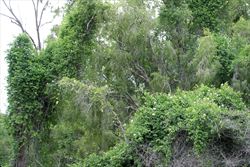
climbing habit (Photo: Chris Gardiner)
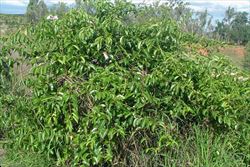
shrubby habit (Photo: Sheldon Navie)

older stems (Photo: Sheldon Navie)

younger stem with raised whitish spots (Photo: Sheldon Navie)

milky sap (Photo: Sheldon Navie)

leathery leaves (Photo: Sheldon Navie)
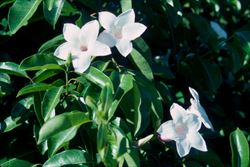
flowers (Photo: Steve Adkins)
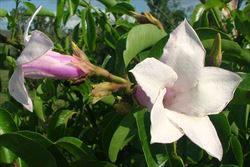
close-up of pale pink tubular flowers (Photo: Sheldon Navie)
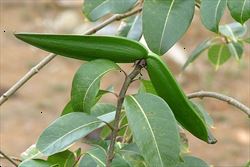
immature fruit (Photo: Sheldon Navie)
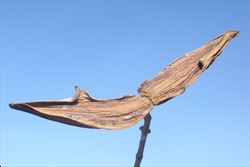
mature fruit (Photo: Chris Gardiner)
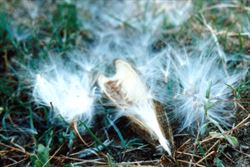
old fruit with seeds (Photo: Land Protection, QDNRW)
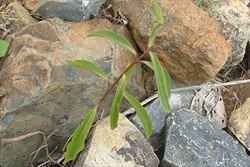
young plant (Photo: Sheldon Navie)

rubber vine rust (Maravalia cryptostegiae), an effective biological control agent (Photo: Sheldon Navie)
Scientific Name
Cryptostegia grandiflora (Roxb.) R. Br.
Synonyms
Nerium grandiflorum Roxb.
Family
Asclepiadaceae (the ACT, Victoria, Tasmania, South Australia, Western Australia and the Northern Territory)Apocynaceae (Queensland and New South Wales)
Common Names
India rubber vine, India rubbervine, Palay rubbervine, purple allamanda, rubber vine, rubbervine
Origin
Native to south-western Madagascar.
Cultivation
This species was cultivated in the warmer parts of Australia, but it is no longer popular because of its invasive reputation.
Naturalised Distribution
Rubber vine (Cryptostegia grandiflora) is widely naturalised in the north-eastern parts of Australia. It is particularly widespread and abundant in the northern parts of Queensland, less common in the central regions of Queensland, and relatively rare in the south-eastern parts of the state. This species is common throughout the river systems of southern Cape York, the Queensland Gulf country, central Queensland and south along the east coast to the Burnett River. Isolated infestations have been found as far south as Gatton and as far west as the Northern Territory border. Infestations have also been located at Mt. Isa, Longreach, Blackall and Charleville. Also recently recorded in the northern parts of Western Australia and possibly naturalised in the Northern Territory.
Naturalised overseas in Mauritius, New Caledonia, south-eastern USA (i.e. Florida), Mexico, Central America, Ecuador and the Caribbean.
Habitat
A weed of semi-arid, tropical and sub-tropical environments. It infests creekbanks and other waterways (i.e. riparian zones), open woodlands, grasslands, closed forests, forest margins, pastures, roadsides, disturbed sites and waste areas. It prefers sites with ample moisture and low shrubs or trees to support its climbing stems.
Habit
A robust woody shrub or climber. Without support it grows into a multi-branched shrub 1-3 m tall, but as a climber it can reach a height of up to 30 m when growing over tall vegetation.
Distinguishing Features
- a robust woody vine or shrub with greyish-brown stems covered with small warty spots.
- its stems and leaves contain a milky sap.
- its paired leaves are thick and leathery with glossy dark green upper surfaces and slightly paler and duller undersides.
- its showy pale pink to whitish flowers (4-6 cm long and 5-9 cm wide) are tubular with a darker throat and five petal lobes.
- its fruit (10-15 cm long and 2-4.5 cm wide) are produced in divergent pairs and contain numerous seeds topped with a silky tuft of white hairs.
Stems and Leaves
The stems are greyish-brown in colour with warty spots (i.e. lenticels) and contain a milky sap (i.e. latex). Younger branches are greenish in colour and hairless (i.e. glabrous). There are two different types of stems produced, branched stems with many leaves (up to 2 m long), and longer unbranched stems (called 'whip' stems) 3-8 m long that either find a support or fall to the ground under their weight and produce leafy side-branches.
The thick and leathery leaves are oppositely arranged along the stems, with dark green and glossy upper surfaces and slightly paler and duller undersides. These leaves are always hairless (i.e. glabrous) and they are borne on stalks (i.e. petioles) 5-20 mm long that are often reddish-purple in colour. The leaf blades (3-10 cm long and 2-6 cm wide) are egg-shaped in outline (i.e. ovate) or oblong and have a broadly wedged (i.e. cuneate) base and blunt or pointed tips (i.e. acute or obtuse apices). Leaf margins are entire or sometimes slightly wavy (i.e. undulate).
Flowers and Fruit
The purplish-pink to whitish coloured flowers (usually pale pink with a darker centre) are large and showy (4-6 cm long and 5-9 cm wide). They are funnel-shaped (i.e. tubular) and have five broad petals that are partially fused (i.e. into a corolla tube). These flowers are borne on short thick stalks (i.e. pedicels) 4-8 mm long and occur in small clusters (usually 6-12 flowers) at the ends of the branches. They also have five relatively narrow (i.e. lanceolate to ovate) sepals (12-19 mm long and 5-10 mm wide), that are joined only at the base, and five stamens. Flowering occurs mainly during summer.
The fruit resemble pods, but they are actually 'follicles', and are produced in divergent pairs. These fruit (10-15 cm long and 2-4.5 cm wide) are greenish or brownish coloured, somewhat three-angled (i.e. triangular) in cross-section, and contain numerous (200-450) seeds. The seeds (5-10 mm long and 1.5-3 mm wide) are brown, flattened and egg-shaped in outline (i.e. ovate). They are topped with a silky tuft of white hairs (i.e. a coma) that are 18-40 mm long.
Reproduction and Dispersal
This plant reproduces mainly by seed, which are usually dispersed by wind and floodwaters. Seeds may also be spread in mud attached to animals and vehicles. Rubber vine (Cryptostegia grandiflora) was probably also spread in dumped garden waste in the past, though it is rarely deliberately cultivated now.
Environmental Impact
Rubber vine (Cryptostegia grandiflora) is a significant environmental weed in northern and central Queensland and a potentially significant environmental weed in Western Australia and the Northern Territory. It is also regarded as a threat in south-eastern Queensland, and was recently listed among the top 30 invasive plant species in this region.
Rubber vine (Cryptostegia grandiflora) threatens waterways, open woodlands and rainforests throughout north-eastern Australia, including significant conservation areas such as the Wet Tropics World Heritage Area and Cape York. It is particularly invasive in riparian areas and can displace the plants and animals that inhabit these habitats. The whole ecological integrity of the native vine thickets and riverine systems of northern Australia is thought to be under threat from this species. It grows rapidly and smothers other plants, often completely dominating the vegetation and spreading aggressively from waterways to adjoining open woodlands and pastures. For these reasons it has been listed among the twenty Weeds of National Significance (WoNS) and is also included the Global Invasive Species Database.
Other Impacts
This species has a very significant negative impact on the pastoral industry in northern Queensland. It is toxic to livestock and dense infestations replace productive species, rendering grazing country less productive or even unuseable. Infestations can also restrict access and increase the costs of mustering and fencing. In 1995, rubber vine (Cryptostegia grandiflora) was estimated to cost the Queensland beef industry $18 million per annum.
Legislation
This species is declared under legislation in the following states and territories:
- ACT: C4 - prohibited pest plant (a pest plant whose propagation and supply is prohibited).
- New South Wales: Class 1 - a state prohibited weed. The presence of the weed on land must be notified to the local control authority and the weed must be fully and continuously suppressed and destroyed (throughout the entire state).
- Northern Territory: A - to be eradicated (throughout all of the Territory), and C - not to be introduced into the Territory.
- Queensland: Class 2 - landowners must take all reasonable steps to keep land free of this species (throughout the entire state). It is also illegal to sell a declared plant or its seed in this state.
- South Australia: 11+ - Class 11 is a category for those species that are 'Weeds of National Significance' but are not otherwise declared in South Australia. Control of this species is not currently required in this state but it is restricted from sale.
- Victoria: R - a restricted weed that poses an unacceptable risk of spread if it were to be sold or traded. It must not be sold, bought or knowingly distributed (throughout the entire state).
- Western Australia: P1 - trade, sale or movement into the state prevented, and P2 - to be eradicated (throughout the entire state).
Management
For information on the management of this species see the following resources:
- the National Weeds Strategy Strategic Plan for this species, which is available online at http://www.weeds.org.au/docs/rvstrat.pdf.
- the Rubber Vine Management Manual, which is available online at http://www.weeds.org.au/WoNS/rubbervine/.
- the Biosecurity Queensland Fact Sheet on this species, which is available online at http://www.dpi.qld.gov.au.
- the Northern Territory Department of Natural Resources, Environment and The Arts Agnote on this species, which is available online at http://www.nt.gov.au/weeds.
- the Western Australian Department of Agriculture and Food information page on this species, which is available online at http://www.agric.wa.gov.au.
Similar Species
Rubber vine (Cryptostegia grandiflora) is very similar to a closely related species that is known as purple rubber vine (Cryptostegia madagascariensis). It is also relatively similar to the garden plant known as purple allamanda (Allamanda blanchetii ). These species can be distinguished by the following differences:
- rubber vine (Cryptostegia grandiflora) has oppositely arranged leaves with slightly reddish or purplish-coloured stalks (i.e. petioles) and midribs. Its younger branches and leaves are always hairless (i.e. glabrous), its flowers are usually pale pink in colour with a much deeper coloured throat, and its paired fruit are commonly each more than 10 cm long.
- purple rubber vine (Cryptostegia madagascariensis) has oppositely arranged leaves with yellowish-green coloured stalks (i.e. petioles) and midribs. Its younger branches and leaves may sometimes be slightly hairy (i.e. puberulent), its flowers are usually uniformly bright pink or purplish in colour, and its paired fruit are always each less than 10 cm long.
- purple allamanda (Allamanda blanchetii) has its leaves arranged in whorls of three or more along its stems (i.e. they are verticillate). Its younger stems and leaves are somewhat hairy (i.e. pubescent), its flowers are usually uniformly bright pink or purplish in colour, and its rounded fruit are rarely seen.
Australian rubber vine (Gymnanthera oblonga) also has a similar habit and grows in the same areas of northern Australia. However, it can be easily distinguished by its much smaller greenish-yellow flowers (less than 2 cm long) and narrower fruit (only 5-6 mm wide).

